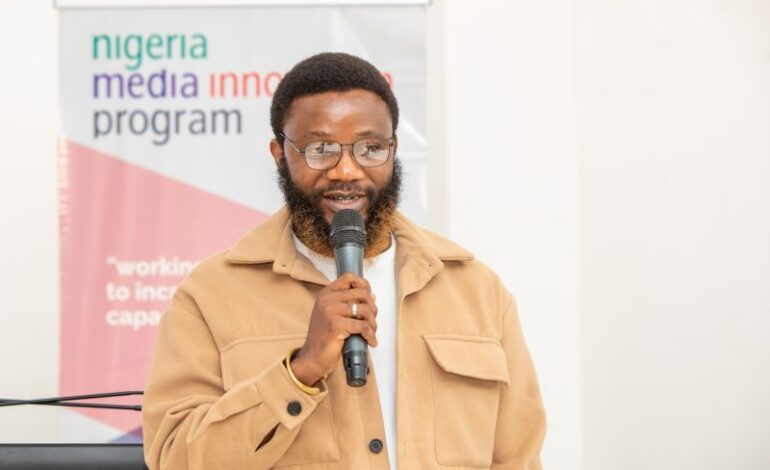Muhammed Akinyemi, popularly known as PrincelyX, is a seasoned award-winning Nigerian journalist who has traversed different roles of journalism and newsroom product management. He has led innovative projects in different newsrooms and is presently Media Advisor with the Media Development Investment Fund’s (MDIF) NAMIP.
In this interview with our correspondent, Noah Aderoju, he spoke about digital metrics monitoring and media product thinking for publishers using his personal experience as a journalist, editor and newsroom product manager.
Akinyemi wants journalists and newsrooms to see and produce news with a mindset beyond altruistic goals, and newsroom leaders to open themselves to learning and innovation.
Many media houses experiment with various platforms, especially now in the age of convergence where they publish on social media and websites. They use newsletters to push their content, but the approach is becoming monotonous without needed improvement. What does digital metrics mean to news publishers, journalists and content creators alike?
What it means depends on who you are asking and depends on what metrics they are tracking and what the objective of the tracking is. The metrics for a newsletter like Forbes Daily or for big publications will be open rate. What’s the open rate? What is the click-through rate? If they have adverts in them, what is the subscription rate? Are they getting more people than they are losing? What is the drop-off rate? Are they losing more than they are getting?
Those are the things that will be important to that kind of publication. For publications that distribute primarily on web, they are going to start tracking things like how many people are seeing our stories, how many people are staying on the stories, how many people are sharing the stories?
Things that matter to publications differ greatly. And what essentially defines that difference is the objective. What I have seen around a lot in our ecosystem is that people just want to do products or have funnels just for the sake of having them, because other publications have them. There are people who have newsletters because they’ve seen other publications run newsletters, but possibly their newsletter is not serving any purpose. So when you start tracking data, they start tracking wrongly.
The fact that that product even exists in the first place means whatever data they are tracking is the wrong data because that is not something that their audience needs or that they’re able to cater to.
So digital metrics are prioritized based on where they follow the business objectives and how, and the platform that the organizations are using to execute the set objectives. So, metrics are different for different publications. Each person is tracking along their business objectives.
Let’s say there’s this media house that has a website. They publish and they promote their content on X (Twitter) too, and they have maybe one newsletter. How important will looking at digital metrics be for them? And what are the things they can use those information for?
I am going to answer the question from a product perspective. Good organizations that build really good native digital products tackle these things in a user journey style. So, what do you want? Think of your process as a product. The product is like an app. So think of that whole process, the distribution process as a product of itself. Think of social media platforms as a product. Think of the website as a product. So, the way they would think of the journey is that they want a good user or experience in that journey.
A good user journey could start from the production process where they are writing the stories and the headlines. What kind of headlines do they think that their users like the most? What kind of presentation do they like? Do they like more pictures or more videos? Do they like it when you use listicles instead of long-form articles? That is where it starts. And then they build the product, which is the story itself. Then they use another product as a funnel for distributing it, which is the website. When your user visits the site, what do you want them to do? Do you want them to read the story and move on? Do you want them to share the story when they are done?
What are the things you want them to do? If you want them to share the story, where do you want them to share it? If you want them to spread your story, where do you want them to put it? When you start tracking digital data, you then start tracking the data of those things. You can track for instance, the rate of people using your website at any point. How about when they join your platform, when they experience your product, they probably drop off after reading two paragraphs, which means that you probably are not doing very well. Your metrics, your measure for success is probably 1000 shares but after reading two paragraphs, they drop off. It means that there’s a problem in the storytelling in that product historically, which then means you have to go back and rethink how you present that product such that the objective is achieved. So the data that the platform is going to be sharing would then be tied to, again, to the objective.
Are they trying to go viral? If they’re trying to go viral, how much of that virality is coming from X (Twitter?) How much of it is coming from Instagram? Also, what does going viral mean for you in terms of distribution? If going viral for you means that you are in the top ten topics, or if it means you are in conversation for three, four, five days, you can create plans around it. So you can do a test story before you drop a big investigation. Or do multiple test stories to see what kind of things your audience responds to. See what things they are more likely to share, gather that data, and then use it to build what the final thing that you want to do is going to be.
So the process and the means, they are tied together. Whatever means you’re trying to achieve is defined by the process. Whatever process you’re trying to achieve is defined by the means. Having a website and distribution on social media, those things are defined by what things are prioritised for people. For some people, they are probably going to prioritize number of subscribers in an episode, the number of people who are clicking turn on post notification, if that is what you are prioritizing. If, at the end of the day, you check your data, you aggregate it, and then you realize that people are not doing what you want them to do, then you have to think of a way to get them to do it. That’s a product perspective.
I know that in newsrooms, we don’t really tend to talk or think of the distribution process in this way because the journalist’s work really has been to go to the field, get the story and get it out. Nobody gives a damn about how it is distributed. You just believe that you’ve done a good story, and when you’ve done a good story for society, people are going to read it. But observing the data, observing the trends, and then plotting towards objectives for those trends, they’re really important. So for your person, their goals are going to define the means and then the means are going to define what success should be for them, basically.
From our conversation so far, we’ve been mentioning product and product thinking, thinking of your media business as a product and not just a matter of doing good stories and just getting it out for people to read. Can you explain what product thinking is for media business.
Generally, product thinking is really just looking at things that serve certain purposes, usually sensitive. And sometimes they are funnels for selling other products. Think of Ali Express platform and Ali Express application. Or think of a product as something as visible as a chair. Usually as a carpenter, you just think of, oh, you want to go to work and make your chair and move on. But if you start thinking of it as a product that needs to be given the most attention, you then start thinking of how to embed this and that, how to make it better, how to get feedback from your audience to ensure that you’re making the best type of chair possible and getting the most money that you can make out of it. So similarly, it is really advisable, as we have seen across the world, especially the northern hemisphere, as you have seen in the global north. It’s really important to start thinking of journalism from a product perspective. So think of it as you have customers and you have a thing that they want to buy, that they want to consume. You have a product they want to buy or a service they want to experience through a product they’re offering, like an app or website, and just start thinking of the best user experience you can provide to this audience to ensure that they want to come back and even be an advocate. Its like you discover something that is so good. Maybe a restaurant, or something like Chowdeck. Each time they eat there they also want to show it and talk about it to their friends. And if it’s not good enough, they are not going to come back for it.
So it’s not just going to be someone going to the farm or going to a backwater community or going to some war-torn part of the country and then get the story out and think I’ve done the bold story, they are idiots if they don’t read it. There are lots of things trying to fight for their attention. You have to fight for their attention.
You know it’s important for them to read it, you know that it’s life-saving, you know that you are doing it for the good of the masses. But if the masses do not see what it is that you are talking about, there is no way for them to know than to ensure that you think about getting to them in the product process.
Ideally, when a media house is thinking of their content as a product that is serving an audience, what are the things that they would have in place or they would do?
The most fundamental thing is to start thinking of their work as a product. And from that, they have to do a lot of strategic thinking around what things they need to make that happen. So, do they need to hire a product developer for the team? Do they need to hire a product manager? Do they need to hire a creative thinker for the team? Whatever it is that they need to do to ensure that they get there. But I think the most fundamental bit is the organization itself coming to terms with the fact that this is the thing that I need and it has to create the facilities to accommodate it.
Some people think journalism should be journalism and the business part should be different from the content. What do you think about this kind of argument that when you are considering too much of this business part, it tends to bring down the quality of journalism that a media house ideally does?
Think of it this way. You are a person who has set out to sell rice and beans. That’s your product. And then you go to the busiest market, you open your store, you have your coolers and whatnot outside and start selling your rice and beans. But people don’t patronize you. And instead of trying to figure out why people are not patronizing you, you are blaming it on the fact that they don’t have taste. Maybe they don’t have taste. Maybe you cook the best rice and beans in the world. Maybe, truly, you have put so much effort into your rice and beans, but those people do not need rice and beans.
You have to figure out a way to ensure that what you are producing, what you are creating, what you are giving the audience, also ties to what your audience need. If it does not, then you might as well just stop selling rice and beans or start thinking of a different line of business. And that’s the difference between a lot of media organizations internationally in the way that a lot of media organizations locally think of in relation to, like, we should separate the business from the media.
Let’s use another example/anecdote. Let’s say you are a paper making company. You make paper and you’re hiring. You’re hiring sales reps and you want them to go sell paper but these people do not know the different sizes of paper. They don’t know what paper people in a particular area use the most. So every time they call an office, the office says they don’t need your paper or your paper is too expensive or something. And you are not taking feedback. You are not going back and listening for more information and trying to see how you can improve your paper or tweak the paper to serve the audience. So by removing the people who do the work of getting the paper done and getting feedback to people who produce paper, which is like the people in the warehouse who do all the cutting, we are creating a problem where we expect people to give us money anyway because we believe our work is noble. But they don’t really care for your work. They don’t need your work. It does not serve them.
You are not giving them anything that they can’t read on NTA or on Twitter. So while it’s really difficult for newsrooms to think about newsroom commercialization, it’s essential if you want to be around for a long time that you think about it as a newsroom. It is the difference between you being able to sell your rice and beans or your paper to people who need it and you knowing that people that you are trying to reach out to. They don’t care about rice and beans or paper. What they want right now is corn and what they need is pencils. If you can’t figure out ASAP by bringing, by creating the kind of environment that allows information to flow from those who make the product to those who distribute the product, then there’s a problem. ]
In a much more practical sense, journalists do not necessarily have to know how to convince the audience to read their story. I know it’s good for personal branding and all of that, but I’m not really a huge fan of journalists being bothered with ensuring that their stories go viral or everybody reads their story. I think it’s necessary that there are departments that do that and neither should journalists be burdened with how to raise money or how to get more, how to position themselves, the organization for investment or grant opportunities.
But it’s necessary for the journalists to know, what quality, what type of stories, the people that you are trying to attract grants or investment opportunities from, what type of stories are they interested in and to produce those kinds of stories. It’s important for your journalists to know that if you write a 5000-word essay and you don’t add like ten pictures or videos, your audience is not going to read it. So maybe the journalist is not going to be the one to sell it. Maybe they’re not going to be the ones to market it or distribute it. But they have to know all the things that make that product go from the kitchen to the stomach of the audience that it needs to get to it.
Let’s quickly go back to where we started, the metrics part. Going in the line of product thinking as we have established, let’s say in the fintech space, the use of metrics is quite clear. You learn that this is the part of my app that my users use mostly, this is the kind of service that they are more interested in and others.
These monitored metrics help them, aside from getting to know the audience and building a better experience for them, in pitching for opportunities like investment and other things.
Is this also the case in the media sector and what other perks does intentionally monitoring metrics offer for media businesses?
Because of my personal bias, I think the most important thing that happens when newsrooms start to pay more attention to their data, as far as I’m concerned is that it changes their product thinking. It takes them from wanting to just write and hope that people like, interact and distribute it, to them being very intentional about the things that they are creating and who it is going to get to.
Again, a difference between Al Jazeera, for instance, where we all know Al Jazeera in every form of Al Jazeera in the mainstream media. We know the TV Al Jazeera, we know Al-Jazeera on the web and so on. But there is also Al Jazeera Labs (AJ Labs), there is Al Jazeera Interactive (AJ Interactive), where they just work in different ways to ensure that they are getting to audiences in ways which other people have not yet thought about. And what this gives them is leverage. Immediately they go through those products thinking by the time they are done and they are giving you a final product everybody is, wowed, and everybody is interested in it.
Recently, FT Strategies released a research work: Next Gen News report, that looked at the way a lot of the audiences are talking about how they want to consume news. If you look at the Nigerian media landscape, you realize that there are very, very few media outfits that are thinking of it.
And the reason it’s not far-fetched. We still think of journalism as some altruistic work, that as long as we keep getting out, their money is going to come somehow. And the fact that we’ve gotten a lot of grants in this space, of recent, has also led to some level of complacency. But it’s very necessary for us to think long-term and think in business terms. And one of the things from that angle is that we need to improve gathering data. Following your data helps you to understand your audience. So you understand your products and understand your audience. And you also understand your business needs. If you are doing multiple projects in your newsroom and you do like a lot of product thinking, audience survey, audience understanding and product understanding and you realize that if you keep going at this rate, you are not going to reach a business objective at all. If you realize that, maybe you need to pivot. If you realize that, maybe you need to do something. All of these things are things that are possible when you start doing a lot of product thinking and you start planning ahead.
You have your products getting better, you have your strong understanding of the audience, you have business thinking, and then you have the ability to attract investment. Because, when you can clean your books, when you can think ahead of your audience, when you can think for and with your audience, it means you’re in a place where when people who want to invest ask you, why should we invest? There’s a clear picture of why they should invest in you.
Not just, oh, I’m doing stories, I’m the best person to have ever covered the story or people need to know this. Yeah, people need to know things. But in the long term, people, whether you tell them or not, people are going to find out about it and people are going to select things that they are going to read about, either it comes from you or it comes from someone else. What you have to learn is to ensure that you’re in a position where even if you’re not the first person to break the news, you’re in a position where you can provide the kind of insight that The Verge provides.
Where they break most of their news in the tech space, but even the news that they are not breaking, when they do the analysis on it, people are subscribing to read those stories because they have angles that show that they understand the audience and what the audience needs, which then puts them in a position where you can attract more investment.
Another good example is The Athletic. With a good product and good audience understanding that puts them in a place where they could be acquired by the New York Times. Those are ways to start thinking about all of these things and to ensure that you are positioning yourself in a way that allows you to be way ahead of the curve and not just everything you’re trying to catch up. So those are the things I can think of right now.
Let’s talk about metrics again. Usually, for social media or newsletter platforms, you can look at your analytics page and dashboard for your metrics. But for websites, the kind of metrics you get can be limited.
What other tools can help media houses get more quality information and quality data metrics about their reports.
There are lots of tools that are going to help you determine what tools you need specifically, depending on what things you want. You can create Looker Studios, and there are different versions of Google Analytics that you can use on the web. There are so many platforms that track data. It depends on what data you are looking for.
Are you looking for data on people who have signed up for a newsletter? In fact, you can do as much as create UTM tags for UTM identifiers for different web links if you want to know where people are visiting your website from. So is it on WhatsApp? Is it on TikTok? Is it on Twitter? You can add different UTM tags to different platforms. And then you see, again, it depends on what data you are tracking and who is helping you track the data. In this case, whatever it is you are looking for, you can be confident that you can find it, as long as it’s data.
Let’s factor in the fact that a lot of publishers may have limited team members and/or have limited knowledge about the technicalities of all these things.
You talk about UTM tags, about Google Analytics, Looker Studio, and things like that. What are they? Can we simplify them? And which of them are free or affordable and can be easily used by those who don’t know much about the technical aspects of the work?
I think the simplest thing to use for web-based platforms, is Google Analytics. So it depends on how you do your configuration, especially since they did Google Analytics 4 (GA4).
Depending on your configuration, you can do everything that you want. You can track your data on your website. It’s just something you use across web platforms. Again, we are talking of small things where you are trying to not spend a lot of money, trying to talk to consultants or maybe digital marketers and the like who can actually do the work for you at a much more intensive level. So for platforms, say, newsletters typically come with their analytics platforms.
What you just have to do is to be able to go to your dashboard and see what exists on those dashboards. The same situation applies to social media. You can see on each post, you can check your analytics, you can see how many people viewed. People went to check your profile after viewing a post, how many people followed you after viewing a post. All of these things are for Twitter. For instance, Twitter analytics exists as its own dashboard away from the platform itself, away from the main Twitter platform where we tweet and whatnot. So if you go to the analytics, you can see your top-performing stories, who followed them the most, and how many people visit your profile in a month. The same thing applies to Instagram, TikTok and all others
So on a superficial level, those things exist because the publishing platforms have also realized that they need to track the data. You need to track data. Everybody needs to track the data. It’s then important for everybody to make sure that they are being tracked. What is missing usually in our situation, is that while those data might have been tracked, we are not extracting them to use them to know how to plan next. So If you do ten stories this month and you share them on your platform, one of them goes viral and the viral one, everybody’s talking about it. But you have three other stories that made 10,000 people follow you. And you checked the viral story and realized that you only made maybe 1000 people follow you.
It means that there’s something that you’ve done right in the ones that did not go viral but attracted people, which means you have to look for what that thing is and to do it better. So an inability to pay attention to the data is really what a lot of people are facing. But then, of course, again, if you want to do much more in-depth work around extracting data using other platforms, creating and even building your platform to extract your data, then you have to start talking to people in engineering, digital marketing to help your newsroom. But at the basic level, data exists you just need to be able to extract it. And the web, which is where most of our publications exist Google Analytics is still the best option.
It is easy to know when you’re having drop-offs, it’s easy to know how many users you have over a particular period of time. It’s easy to know how many views you have and so on and so forth.
Looking at the Nigerian media space now, we have many people in the sector, in news publishing, content creators, journalists and many others.
If you would give them one piece of advice to help them improve their work on a whole new level, What would it be?
It may be something they’ve not been taking note of and they need to take something they’ve been doing not so well that they need to change ways.
I think in our space, we need to be much more. We need to plan for long periods, and not just for now. We need to play the waiting game. We need to play the long-term game and not really just for now. There’s a lot of media houses or media products that I’ve seen and I continue to see. There is this situation where people consistently and constantly just wake up one morning and want to start a publication, which is okay. I mean, there are a lot of 20k 30k newsletters that started that way. And that’s one thing on one part, but being able to plan and think long-term means you have to open yourself to the possibility that the things that you know are limited. And if you want to be around for a long time, you have to start planning to ensure that the skills that you like, you can train for it, you can prepare for it, you can learn it, or you can bring in people who are going to fill in those capacity gaps.
For so many media houses, people just want to come in, get the glory of whatever glory they are seeking and, you know, jet out. Maybe in the old business way of thinking, it works, but the business space right now has really changed. It’s no longer the reporter is doing his own story and then it does, not matter what happens, I’m going to get some adverts and business continues as usual.
Things are different. You’re probably going to want to turn on Google Ads on your platform to make some money from Adsense.
You’re not going to make money from Adsense if you have nonsense on your site. So part of thinking long term is thinking, do I want to activate Google AdSense today or do I want to activate Google Adsense in two months? Part of thinking long term is thinking do I want to hire 20 people today, so we can do 1000 stories or do I want to hire five people so that when we do ten stories in a week, each story that we do is a hit. So long-term thinking is very necessary in the media space.
We have to invest, not just for today, but to ensure that even if tomorrow the person who is very passionate about the said media business quits or they are unable to forge on, maybe even die, the business can continue without them because there’s a vision that supersedes, that can outlive that person’s ideologies.
Its established that there are no big-time advertisers anymore and grants will not reach everybody. So when we think about sustainability, in terms of being able to sustain the work we do, being able to sustain the platform we use, being able to continuously do the great work that we want to do as media houses or as journalists, what advice would you give?
I am speaking in my personal capacity as someone who has had to apply for grants with one of the most sterling applications possible and was able to get grants from outside the country but could not get in the country. Nigeria’s grant landscape is pretty political. It’s a lot of friendship and it’s not necessarily a bad thing. But because a lot of those grants come in from the friendship arena, it eliminates the place for accountability. Because, when you help your friend get a grant, and when the grant starts getting executed, your friend starts mismanaging funds, but it’s your friend. And you’re probably going to them at Christmas or during Eid and share chicken with them or break bread with them, as the case may be.
People are less likely inclined to be honest with their friends about the lack of accountability and mismanagement. And it keeps creating this situation where instead of fixing sustainability by thinking of commercialization, we are thinking of fixing sustainability by looking for which of our friends is on the board or sitting on another grant that’s coming to the country that we can quickly lobby to get the next grant for our organization.
Grants are not going to be forever as we are currently experiencing. There are going to be times when grants are going to be withdrawn. There are going to be times when they are not going to be as plenty as they used to be.
So we have to create a media ecosystem that can sustain itself outside of grants. And until the accountability that we so love to demand from politicians, until we can demand it from ourselves in the media space, it could be a very huge problem. Because why do I need to spend money on the things that I said I was going to spend money on if nobody is going to really ask me or audit how I spent the money? And there are no consequences, too. So those are things to really consider.
It’s a very long walk to where we are going, but I’m very confident that we have a media space that has the capacity to change itself and to change the country. And that is going to happen. It is going to take a while, but it’s definitely going to happen.
And once that change from the media space starts where we can be accountable through, and not just on the face of it, or not just so that we can have someone clean books for us, it then makes it easier for media owners to start demanding thorough accountability from politicians, not ones where they are also paid to kill. Accountable to such an extent that you can build financial sustainability that is not dependent strictly on getting money from politicians. Then it gives you the leverage you want to do more powerful stories and be much more independent to ask questions, release documents to reveal this and that. Again, I’m very confident that we’re going to get there. It’s going to take a while, but we will get there.
It’s been me asking questions so far and requesting for a certain information. I would like to ask what you want to add to this conversation? What do you feel you need to be added to this conversation?
Not necessarily what you should have added, but more of a reiteration.
I think very strongly that we need to, by we, I mean like publishers and editors in chief, we need to open ourselves to the truth that we’re not perfect. A lot of people have done this media work for a long time. Many of them have done the media work longer. Longer than I’ve been alive. But things are changing and they are changing very rapidly.
The difference between media five years ago and media in the next five years is a different ballgame entirely. So we have to be able to bring ourselves to understand that the things that we do not know are just things that we do not know. We don’t have to pretend. We don’t have to fake it. It can’t be faked.
And with us having to rely more on data to make decisions, you can’t fake a lack of data or you can’t fake your way through the presence of data. The things that are not there and things that they are there.
So we need more publishers and editors in chiefs and CEO’s to open themselves to learning more, to allowing people in their newsrooms, in the organization generally, who are innovative, to operate with more freedom and to provide as much independent support as they can. We have to innovate really fast and we have to build for Africa, we have to build for Nigeria.
The recent AI wave and conversations around what AI is going to do to different industries. We are not precluded from it. It is going touch the digital space. We have an opportunity to start learning today so that we can also determine what that usage is going to be. Otherwise we are going to take the backseat and then someone from New York or from Bay Area in the US is going to determine what that is going to be for us.
Again, it really starts from us learning, allowing ourselves to be taught and understanding that we don’t know everything. And there’s so much more to know and to be known. Humility, knowledge and allowing people who have creativity to get things done to operate freely.





